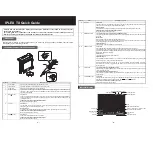
5-2
Relative, mX+b, m/X+b (reciprocal), and log
Relative
Relative (Rel) nulls an offset or subtracts a baseline reading from present and future read-
ings. When a Rel value is established, subsequent readings will be the difference between
the actual input and the Rel value.
Displayed (Rel’ed) Reading = Actual Input - Rel Value
A Rel value is the same for all measurement ranges. For example, a Rel value of 1E-6 is
1
µ
A on the 2
µ
A range. It is also 1
µ
A on the 20
µ
A range and the 200
µ
A range. Note
changing ranges does not disable Rel.
Front panel relative
From the front panel, there are two ways to set the Rel value. You can either use the input
reading as the Rel value, or you can manually key in the Rel value.
To use the present reading, first disable zero check, display the reading, then press REL.
The REL annunciator will turn on, and subsequent readings will be the difference between
the actual input and the Rel value. To disable relative, press REL again while zero check is
disabled. To enter a reading, press CONFIG then REL, enter the desired value, then press
ENTER. Relative will be enabled after you enter the value.
NOTE
Separate Rel values are stored for the amps and ohms functions.
SCPI programming — relative
Table 5-1
SCPI commands — relative (null)
Commands
Description
CALC2:FEED <name>
CALC2:NULL:ACQ
CALC2:NULL:OFFS <Rel>
CALC2:NULL:STAT <b>
CALC2:DATA?
CALC2:DATA:LAT?
INIT
Specify reading to Rel: SENS or CALC1.
Use input signal as Rel value.
Specify Rel value: -9.999999e20 to 9.999999e20.
Enable (ON) or disable (OFF) Rel.
Return Rel’ed readings triggered by INIT.
Return only the latest Rel’ed reading.
Trigger one or more readings.
Summary of Contents for 6487
Page 13: ......
Page 15: ......
Page 35: ...1 20 Getting Started Model 6487 User s Manual...
Page 47: ...2 12 Connections Model 6487 User s Manual...
Page 61: ...3 14 Measurements and Sourcing Voltage Model 6487 User s Manual...
Page 85: ...7 8 Remote Operation and Commands Model 6487 User s Manual...
Page 86: ...A Specifications...
Page 88: ...B GeneralMeasurement Considerations...
Page 94: ...C ExamplePrograms...
Page 101: ......
Page 103: ......
Page 104: ......
















































